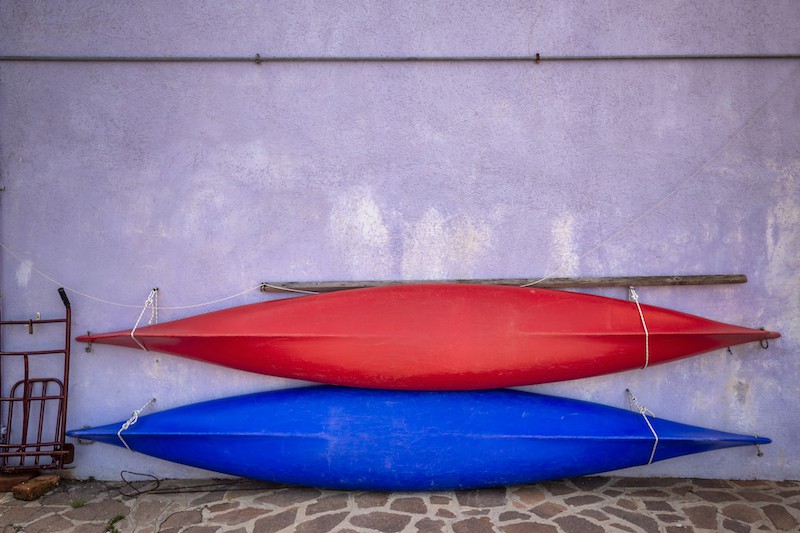Kayaking can be a great choice for spending a fun weekend and enjoying the relaxing atmosphere of the lake. However, one problem might be stopping you from indulging in this adventurous activity. You don’t have enough space to store a kayak inside.
Don’t worry. I’ve got a solution to your problem. You can store the kayak outside. While outside storage is not the best choice for keeping a kayak away from the elements, it’s possible.
Don’t know how to do it? You’re lucky. Today we’re going to talk about how to store a kayak outside.
What do you need to store a kayak outside?

Let’s begin tacking the problem from the beginning and make a list of what you’d need if you want to keep your vessel outside:
- Cleaning supplies
- Kayak protectant
- Weather-resistant tarp/tent
- Kayak rack (if you have a suitable outside structure)
#1 Find a suitable spot
As I already mentioned, it’s preferable to store a kayak inside because it will be more protected against the elements and less likely to get damaged. But that’s not possible for people who live in small apartments and condos.
So, first, you’d have to find a suitable place outside. No matter the type of kayak you have, exposure to sunlight, moisture, and heat/cold can damage the hull and deform it in time. So:
- Look for a shady spot. It could be under the deck or below the eaves of a roof.
- Consider a weather-resistant tarp to cover the vessel even if you have a suitable outside location to keep dust, sand, or pets away from it.
- Ice, rain, and snow should not collect anywhere near the kayak, or they are going to damage it.
- Finally, it shouldn’t be too difficult to retrieve the kayak from its storage spot.
#2 Prepare the boat for storage
Once you’ve found the perfect outdoor spot for your kayak, you can start the next step – preparing the kayak. So:
- Remove the seats, the soft fabric components, and the paddles. Specialists recommend that you store them separately inside.
- Get water and mild soap.
- Clean the vessel well to remove any dirt, sand, grime, or salt. If you don’t do this, you risk mold or fungus growing and deform it in time.
- Don’t forget to clean the inside, as well as the outside.
- Rinse with clean water to remove any leftover soap.
- Pat the vessel with a towel and let it dry completely. Any moisture might lead to fungus growth, something you don’t want.
- Spray the boat with sun protective spray to avoid UV damage.
#3 Place the kayak correctly
There are a couple of things you have to know about kayak storage, no matter if you’re keeping it inside or outside:
- The kayak shouldn’t lie flat on the ground
- The weight has to be distributed evenly, or the hull will bend.
- You should place it near a heat source or in direct sunlight
- Temperatures above 100 Fahrenheit and below the freezing point should be avoided
- Do not strap the vessel tightly or the pressure points might damage the kayak
- Watch this video for more information:
For inside storage, one way to save space will be to suspend the kayak from the ceiling. As you can imagine, this could be quite impossible outside. So, what can you do? You have several options:
- Place it vertically with the bow up towards the ceiling.
- Place it horizontally on its side (cockpit towards you, the hull – the wall)
- Use a kayak rack. If it’s possible to install one outside on a sturdy structure
For vertical storage, the kayak should be at a slight angle to keep it stable. To protect the stern, you can get a small crate, fill it with cushions and place the stern inside.
If you choose the horizontal position, experts recommend that you tilt it on the other side at least once a month to avoid damage. That’s obligatory if you’re preparing the kayak for winter storage.
As for kayak storage rack, you can build one easily by following this tutorial. Or go shopping for one.
#4 Cover the kayak
After you’ve placed the kayak outside, it’s a good idea to cover it for protection. If full coverage is not possible, you have to take care of the cockpit at least.
The best you can do is to use a waterproof tarp to create a tent-like structure under which you’d stow the vessel. To do that:
- In between two poles or trees, tie a rope a few inches off the group.
- Drape the tent over the rope.
- Make sure that the construction doesn’t sag or rain, snow, ice, etc. will press upon the kayak.
- checkCheck from time to time to ensure that the rope hasn’t gotten slack and take measures if you notice that it’s about to fall off.
#5 Prepare the kayak for winter storage
If you live in a place where it gets extremely cold during the winter, you should try to find a place for your kayak inside. It might be a shed, a garage, or a closet, but inside is better than outside. However, if you absolutely have to leave it outside:
- Cover it well with a full boat cover and a cockpit cover.
- Don’t allow snow to pile over the tent.
- Avoid leaving it on the ground for an extended period of time.
- checkUse a kayak rack to keep the boat off the ground.
#6 Protect your kayak from theft
One of the biggest worries about storing your kayak outside, besides it getting damaged due to bad weather, is that somebody might steal it in the night. A well-made kayak is quite the investment, so you should take preventive measures to make sure that no one will run away with it. So:
- Try to keep the vessel hidden as much as possible.
- Ensure that it’s not easy to remove it from its position.
- Consider a steering wheel lock across the cockpit.
- checkThread a security cable through the wire grab loop and lock it to something sturdy like a post.
#7 Look for other options
What can you do if you discover that you don’t have any available outdoor spots to stow your kayak? Well, in this case, you can see if your local paddling center doesn’t have storage options available.
What’s the excellent thing about this solution is that these centers and kayak outfitters have the proper storage solutions for all types of kayaks and you’d have to do very little to keep your vessel in top shape. In addition to this, you’d be near the water, so you wouldn’t have to worry about transporting the kayak.
The bad thing is that you’d have to pay rent, but you’d also have professionals to help you along if you’re not certain what to do.
Storing a kayak outside is achievable as long as you take the necessary measure so that your vessel is not exposed to sunlight and harsh weather conditions. Also, it’s important to buy the correct rack/suspension mechanism for your type of kayak.
What do you think about these tips on how to store a kayak outside? How do you store your kayak? Share your advice in the comment section.
